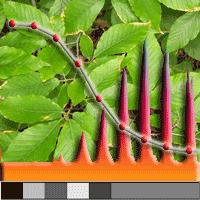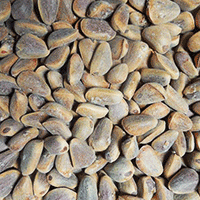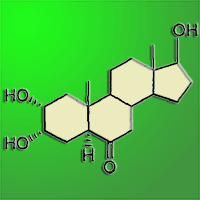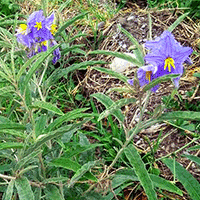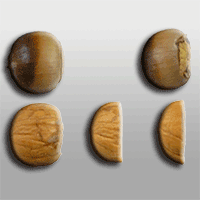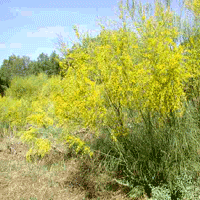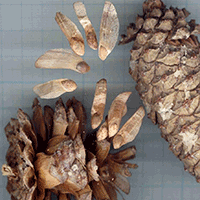
Identification and allelochemical activity of phenolic compounds in extracts from the dominant plant species established in clear-cuts of Scots pine stands
Vaida Šežiene (1), Ligita Baležentiene (2) , Audrius Maruška (3)
iForest - Biogeosciences and Forestry, Volume 10, Issue 1, Pages 309-314 (2017)
doi: https://doi.org/10.3832/ifor1791-009
Published: Feb 23, 2017 - Copyright © 2017 SISEF
Research Articles
Abstract
Dominant plant species established in the understory of clear-cuts may have a strong biochemical influence on pine regeneration process, with important consequences for reforestation management. We evaluated and compared the total phenolic content and the allelopathic activity of acqueous extracts from both roots and shoots of dominant plant species established in 1-yr-old and 2-yr-old clear-cuts of Scots pine (Pinus sylvestris L.) stands in Lituania. The highest total content of phenolic compounds was detected in the lingonberry (Vaccinium vitis-idaea L.) shoots from 1-yr-old and 2-yr-old clear-cuts, as well as in the common heather (Calluna vulgaris [L.[ Hull) shoots from 1-yr-old clear-cuts. High-performance liquid chromatography (HPLC) was used to identify and quantify the allelochemicals present in the active fraction to determine their possible role in allelopathy. The highest variety and content of phenolic compounds were observed in shoot extracts of the dominant species from both 1-yr-old and 2-yr-old clear-cuts. Scots pine seed germination and seedling growth were significantly and negatively correlated with ρ-coumaric acid and sinapic acid content, while Scots pine seedling growth was significantly and negatively correlated with ferulic, caffeic and hydroxycinnamic acids contents. The highest contents of these phenolic acids were determined in aqueous extracts of C. vulgaris from 1-yr-old clear-cuts and Rumex acetosella L. of 2-yr-old clear-cuts, which exerted a strong phytotoxicity on Scots pine seed germination. Moreover, morphometric parameters of Scots pine seedlings were most sensitive to aqueous extracts of V. vitis-idaea shoots from both 1-yr-old and 2-yr-old clear-cuts and R. acetosella shoots from 2-yr-old clear-cuts.
Keywords
Phenolics Identification, Allelopathy, Dominant Species, Germination
Authors’ Info
Authors’ address
Department of Ecology, Forest Research Institute, Lithuanian Research Centre for Agriculture and Forestry (Lithuania)
Institute of Environment and Ecology, Aleksandras Stulginskis University (Lithuania)
Department of Biology, Vytautas Magnus University (Lithuania)
Corresponding author
Paper Info
Citation
Šežiene V, Baležentiene L, Maruška A (2017). Identification and allelochemical activity of phenolic compounds in extracts from the dominant plant species established in clear-cuts of Scots pine stands. iForest 10: 309-314. - doi: 10.3832/ifor1791-009
Academic Editor
Giorgio Matteucci
Paper history
Received: Aug 05, 2015
Accepted: Sep 12, 2016
First online: Feb 23, 2017
Publication Date: Feb 28, 2017
Publication Time: 5.47 months
Copyright Information
© SISEF - The Italian Society of Silviculture and Forest Ecology 2017
Open Access
This article is distributed under the terms of the Creative Commons Attribution-Non Commercial 4.0 International (https://creativecommons.org/licenses/by-nc/4.0/), which permits unrestricted use, distribution, and reproduction in any medium, provided you give appropriate credit to the original author(s) and the source, provide a link to the Creative Commons license, and indicate if changes were made.
Web Metrics
Breakdown by View Type
Article Usage
Total Article Views: 49822
(from publication date up to now)
Breakdown by View Type
HTML Page Views: 41736
Abstract Page Views: 2744
PDF Downloads: 4293
Citation/Reference Downloads: 21
XML Downloads: 1028
Web Metrics
Days since publication: 3216
Overall contacts: 49822
Avg. contacts per week: 108.44
Citation Metrics
Article Citations
Article citations are based on data periodically collected from the Clarivate Web of Science web site
(last update: Mar 2025)
Total number of cites (since 2017): 11
Average cites per year: 1.22
Publication Metrics
by Dimensions ©
Articles citing this article
List of the papers citing this article based on CrossRef Cited-by.
References
Biochemical impact of dominants’ extracts of Scots pinewood cuttings on germination. Polish Journal of Environmental Studies 19 (1): 35-42.
Gscholar
The phytotoxicity and accumulation of secondary metabolites in Heracleum mantegazzianum (Apiaceae). Allelopathy Journal 33 (2): 267-276.
Gscholar
Pflanzensoziologie. Grundzüge der Vegetationskunde [Plant sociology: the study of plant communities]. Aufl. Springer Verlag, Wien, Austria, pp. 865. [in German]
Gscholar
Vegetation ecology of Central Europe. Cambridge University Press, Cambridge, UK, pp. 756.
Gscholar
Inhibitory activity of allelochemicals on barnyardgrass (Echinochloa crus-galli L) seed and seedling parameters. World Applied Sciences Journal 17 (11): 1535-1540.
Gscholar
The ecology of plant secondary metabolities. From genes to global process. University press, Cambridge, UK, pp. 335.
Gscholar
ISTA Method validation for seed testing. The International Seed Testing Association (ISTA), Basedorf, Switzerland, pp. 1-66.
Gscholar
Age-related dynamics of pine forest communities in Lithuania. Baltic Forestry 9 (1): 50-62.
Gscholar
Assessment of allelopathic potential of selected medicinal plant of Pakistan. African Journal of Biotechnology 8 (6): 1024-1029.
Gscholar
Lingonberry (Vaccinium vitis-idaea) and European Cranberry (Vaccinium microcarpon) proanthocyanidins: isolation, identification, and bioactivities. Journal of Agricultural and Food chemistry 59: 3373-3384.
CrossRef | Gscholar
Chemical composition in aqueous extracts of Potamogeton malaianus and Potamogeton maackianus and their allelopathic effects on Microcystis aeruginosa. Polish Journal of Environmental Studies 19 (1): 213-218.
Online | Gscholar


